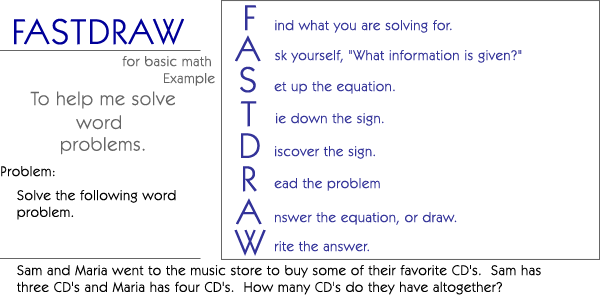 |
|
|||||
| |
|
|
|
|
|
|
| |
|
|
||||

-
Look for the question mark.
-
Underline the information that tells you what you are solving for.
-
Look at the keywords.
- Underline them twice.

"Let's see, the first thing I need to do is look for the question mark. There it is - right before that it tells me the information I am solving for. I am going to underline 'How many CD's do they have altogether?' Now I am going to look for key words. The key word here is altogether. I am going to underline altogether twice."
A sk yourself, "What information is given?"
-
Read each sentence.
- Find number phrases and circle them.
" Now I need to look for the important information. Let's see, in the first sentence I know that Sam and Maria went to buy some CDs. That's good information, but there are no number phrases in that sentence. I'll move to the next sentence. 'Sam has 3 CD's and Maria has 4 CD's'. That has number phrases in it. I'll circle those phrases."

-
Write the equation with the numbers in the correct order.
"Now that I know what I want to solve for, and I've found the important information, I'm ready to set up the equation."

Tie down the equation.
-
Reread the underlined sentences.
- Check highlighted key words.
- Explain the operation.
"I need to decide which operation to use. I am going to go back and read the underlined sentence. 'How many CD's do they altogether?' The key word is altogether. Altogether means to add. I am going to add to see how many CD's Maria and Sam bought together."

-
Find the sign.
-
Circle the sign.
-
Say the name of the sign aloud.
"Let's see I need to look at the problem and find the sign. Well, there is only one sign, so I will circle it. It is an addition sign."

R ead the problem.
-
Say the problem aloud.
"The problem I need to solve is 3 plus 4."
-
See examples for how to draw answers.
-
Be sure to double-check your answer.
"Now I need to answer the problem. I could draw the answer. If I drew the answer, I'd put three tally marks for Sam's CD's, and I'd put four tally marks for Maria's. Then I'd count up how many tally marks I have altogether. But I don't need to draw the answer. I know that three plus four equals seven."
-
Write down the answer to the problem.
"So, I know that 3 + 4 = 7. I will write 7 for the answer. That is how many CD's Sam and Maria have altogether."
| |
|
|
|
|
|
|
|
| |
 |
||||||
|
|
|
||||||
| |
|
||||||
| |
|
|
|
|
|||
| |
|
|
|||||